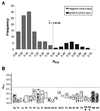Immunodiagnosis of human fascioliasis by an enzyme-linked immunosorbent assay (ELISA) and a micro-ELISA
- PMID: 11139214
- PMCID: PMC96029
- DOI: 10.1128/CDLI.8.1.174-177.2001
Immunodiagnosis of human fascioliasis by an enzyme-linked immunosorbent assay (ELISA) and a micro-ELISA
Abstract
Enzyme-linked immunosorbent assay (ELISA) and micro-ELISA were evaluated for their ability to detect anti-Fasciola hepatica antibodies in humans by using excretory-secretory antigen. The sensitivity of each method was 100%, but the specificity was 100% for ELISA and 97% for micro-ELISA. The micro-ELISA could be used as a screening assay and ELISA could be used as a confirmatory method for the serodiagnosis of human fascioliasis.
Figures


Similar articles
-
[Indirect ultra-micro-ELISA for detecting IgG antibodies in patients with fascioliasis].Rev Cubana Med Trop. 1997;49(3):167-73. Rev Cubana Med Trop. 1997. PMID: 9685983 Spanish.
-
Evaluation of specific Fasciola antigen in the immunodiagnosis of human fascioliasis in Egypt.J Egypt Soc Parasitol. 1994 Dec;24(3):463-70. J Egypt Soc Parasitol. 1994. PMID: 7844410
-
The use of MM3 monoclonal antibodies for the early immunodiagnosis of ovine fascioliasis.J Parasitol. 2007 Feb;93(1):65-72. doi: 10.1645/GE-925R.1. J Parasitol. 2007. PMID: 17436943
-
Serodiagnosis of fasciolosis in ruminants.Rev Sci Tech. 1990 Jun;9(2):511-8. doi: 10.20506/rst.9.2.499. Rev Sci Tech. 1990. PMID: 2132693 Review.
-
Fas2-ELISA in the detection of human infection by Fasciola hepatica.J Helminthol. 2005 Sep;79(3):235-40. doi: 10.1079/joh2005303. J Helminthol. 2005. PMID: 16153317 Review.
Cited by
-
Recent Developments in Recombinant Proteins for Diagnosis of Human Fascioliasis.Acta Parasitol. 2021 Mar;66(1):13-25. doi: 10.1007/s11686-020-00280-5. Epub 2020 Sep 24. Acta Parasitol. 2021. PMID: 32974849 Review.
-
Leucine aminopeptidase is an immunodominant antigen of Fasciola hepatica excretory and secretory products in human infections.Clin Vaccine Immunol. 2008 Jan;15(1):95-100. doi: 10.1128/CVI.00338-07. Epub 2007 Nov 14. Clin Vaccine Immunol. 2008. PMID: 18003812 Free PMC article.
-
Fasciola hepatica and Schistosoma mansoni: identification of common proteins by comparative proteomic analysis.J Parasitol. 2011 Oct;97(5):852-61. doi: 10.1645/GE-2495.1. Epub 2011 Mar 11. J Parasitol. 2011. PMID: 21506812 Free PMC article.
-
Hepatic mass caused by Fasciola hepatica: a tricky differential diagnosis.Am J Trop Med Hyg. 2013 Dec;89(6):1212-3. doi: 10.4269/ajtmh.13-0085. Epub 2013 Sep 30. Am J Trop Med Hyg. 2013. PMID: 24080633 Free PMC article.
-
Fasciola hepatica ESPs Could Indistinctly Activate or Block Multiple Toll-Like Receptors in a Human Monocyte Cell Line.Ann Clin Pathol. 2017;5(3):1112. Epub 2017 Mar 31. Ann Clin Pathol. 2017. PMID: 29152559 Free PMC article.
References
-
- Apt W, Aguilera X, Vega F, Zulantay I, Retamal C, Apt P, Sandoval J. Human fascioliasis in rural areas of Central Chile. Rev Med Chile. 1992;120:621–626. - PubMed
-
- Arjona R, Riancho J, Aguado J, Salesa R, Gonzalez-Macias J. Fascioliasis in developed countries: a review of classic and aberrant forms of the disease. Medicine. 1995;74:13–23. - PubMed
-
- Bjorland J, Byran R T, Strauss W, Hillyer G V, McAuley J B. An outbreak of acute fascioliasis among Aymara Indians in the Bolivian Altiplano. Clin Infect Dis. 1995;21:1228–1233. - PubMed
-
- Bradford M M. A rapid and sensitive method for the quantitation of microgram quantities of protein utilizing the principle of protein-dye binding. Anal Biochem. 1976;72:248–254. - PubMed
-
- Bryan R T, Michelson M K. Parasitic infections of the liver and biliary tree. In: Surawicz C, Owen R L, editors. Gastrointestinal and hepatic infections. W. B. Philadelphia, Pa: Saunders Company; 1995. pp. 405–454.
MeSH terms
Substances
LinkOut - more resources
Full Text Sources

